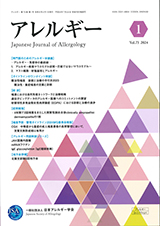
- Issue 3 Pages 231-
- Issue 2 Pages 155-
- Issue 1 Pages 1-
- |<
- <
- 1
- >
- >|
-
Sari Hatanaka, Yoshitaka Honda, Hideki Ueno2024 Volume 73 Issue 3 Pages 231-238
Published: 2024
Released on J-STAGE: May 16, 2024
JOURNAL RESTRICTED ACCESSDownload PDF (769K)
-
Teruki Dainichi, Kenji Kabashima2024 Volume 73 Issue 3 Pages 239-248
Published: 2024
Released on J-STAGE: May 16, 2024
JOURNAL RESTRICTED ACCESSDownload PDF (1151K) -
Masanori Kidoguchi2024 Volume 73 Issue 3 Pages 249-253
Published: 2024
Released on J-STAGE: May 16, 2024
JOURNAL RESTRICTED ACCESSDownload PDF (500K)
-
Mizuho Nagao2024 Volume 73 Issue 3 Pages 255-259
Published: 2024
Released on J-STAGE: May 16, 2024
JOURNAL RESTRICTED ACCESSDownload PDF (480K)
-
Tetsuhiro Sakihara2024 Volume 73 Issue 3 Pages 260-267
Published: 2024
Released on J-STAGE: May 16, 2024
JOURNAL RESTRICTED ACCESS
-
Takeya Adachi, Motoshi Hayano, Yasunori Ito, Takenori Inomata, Yasushi ...2024 Volume 73 Issue 3 Pages 268-278
Published: 2024
Released on J-STAGE: May 16, 2024
JOURNAL RESTRICTED ACCESSBackground: In 2022, the “New Capitalism Grand Design and Implementation Plan” was adopted in Japan, emphasizing the promotion and environmental development of startups. Given this context, an investigation into the startup and investment landscape in the allergy sector, both domestically and internationally, becomes imperative.
Methods: We analyzed 156 allergy-related startups from Japan, the US, and Europe from 2010 to 2021. Data on corporate information and investment trends were extracted from databases and VC websites.
Results: The total investment reached approximately 7.2 billion USD, with a ratio of 20:6:1 for the US, Europe, and Japan, respectively. The US showed a decline post its peak from 2016-2018, while Europe and Japan experienced growth. Notably, the US primarily invested in biopharmaceuticals for atopic dermatitis and food allergies, Europe in asthma-related apps, and Japan in healthcare apps and cross-border startups.
Discussion and conclusion: While Japan's investment environment in the allergy sector remains in its nascent stages and has room for development, the US and Europe are evidently ahead. Considering the rise of startups and funding limitations in Japan, external funding from regions like the US becomes a potential avenue. These findings are anticipated to contribute to the strategic activation of startups in allergy research and development.
View full abstractDownload PDF (549K) -
Tomoyuki Kimura, Shintaro Suzuki, Ryota Kumaki, Keiko Kishimoto, Tomok ...2024 Volume 73 Issue 3 Pages 279-289
Published: 2024
Released on J-STAGE: May 16, 2024
JOURNAL RESTRICTED ACCESSBackground and Aim: We previously reported that pharmacists working in pharmacies don't have enough knowledge and enough experience teaching anaphylaxis (An) and EpiPen use. We administered a questionnaire survey to pharmacists with experience handling EpiPen prescriptions. We investigated the relationship between the questionnaire results and the factors in the pharmacists' background regarding the explanation and guidance to patients.
Results: The percentage of pharmacists working in pharmacies who provided guidance using visual information and demonstrations was insufficient. Moreover, this figure decreased after the second guidance session. Objective confirmation of patient understanding was also insufficient. The results indicated that self-examination and participation in drug information sessions were important background factors for pharmacists who provided detailed guidance to patients.
Discussion: For appropriate long-term management of their condition, An patients must master the EpiPen technique. Pharmacists' guidance plays a critical role in this regard. A support system should be established for proper instruction of pharmacy patients by improving pharmacists' self-education and other educational opportunities.
View full abstractDownload PDF (2645K)
-
Jun Shirota, Hiroko Sakuma, Fumi Mashiyama, Naoko Suzuki, Yuka Takeda, ...2024 Volume 73 Issue 3 Pages 290-293
Published: 2024
Released on J-STAGE: May 16, 2024
JOURNAL RESTRICTED ACCESSHerein, we report the case of a 7-year-old girl with a history of atopic dermatitis because of infancy. Her grandfather grew Egoma (Perilla frutescens), and her family frequently consumed food items prepared using Egoma; however, she never consumed them because she did not enjoy these food items; she experienced vomiting, facial swelling, and oral discomfort upon ingesting Egoma during school lunch for the first time. Her food oral challenge test was positive, as well as a skin-prick test with sesame powder. Egoma antigen protein was extracted and reacted with patient serum by immunoblotting, which detected a positive band of approximately 26kDa. She was brought up in an environment with high exposure to Egoma; hence, she most likely developed an allergy to Egoma because of percutaneous sensitization. This is the first time an Egoma allergen analysis has been conducted in Japan, and we consider it to be a valuable case.
View full abstractDownload PDF (354K)
-
[in Japanese], [in Japanese], [in Japanese], [in Japanese], [in Japane ...2024 Volume 73 Issue 3 Pages 294
Published: 2024
Released on J-STAGE: May 16, 2024
JOURNAL RESTRICTED ACCESSDownload PDF (507K)
-
[in Japanese]2024 Volume 73 Issue 3 Pages 295-296
Published: 2024
Released on J-STAGE: May 16, 2024
JOURNAL RESTRICTED ACCESSDownload PDF (622K)
- |<
- <
- 1
- >
- >|